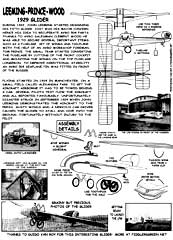



LPW-1922-Glider - $$4.50
John F. Leeming and a group of friends started to build a glider in Leeming's garage at his home in Bowdon near Altrincham Cheshire. When the 'LPW' glider was completed in early 1924, it was taken to Alexandra Park Aerodrome. The club flew the glider many times at Alexandra Park, launching it by towing behind a car.
The Leeming, Price & Wood (LPW) 1920s Glider


In 1922 John Leeming started to design his fifth glider, which became the LPW Glider, as the
cheapest possible way to get airborne, but even the cost of materials
worried him. He knew that Avro had made 8,340 Avro 504K trainers,
and many were then stored but unwanted.
So he approached Avro to seek scrap materials, and met Clement Wood of the Sales staff, who turned out to be a kindred spirit. They raided the "scrap pile" and probably got major components needing minor repairs. The most costly items were two bicycle wheels that cost full price.
The Daily Mail gliding contest at Itford came and went in October 1922. The LPW had been started, but they didn't join the scramble to make an instant glider. The Brokker (Fokker D.7 wing panels on a Bristol Fighter body) soared the hill for an hour, which must have been very encouraging.
Whilst struggling with the Gloster E.28/39
cockpit I needed a break... and accidentally discovered
reference to the Leeming-Prince-Wood 1922 glider. Since
the original was converted from an Avro 504K trainer I decided
to do likewise.. using the old FG model. To fit in with
the rest of your glider collection I decided to redraw the
parts I needed and added some new parts where appropriate. 
Let's make it clear:
This is a model NO modeler is waiting for and I do not think
it deserves any more time to be invested into it. I have
it in my collection, and that's most of the fun for me !
Anyway, in case you would like to offer it to fellow modelers
:
- http://www.bfgc.co.uk/history/chapter3.htm and
http://www.bfgc.co.uk/history/lpw.htm where the only references
I used.
-I redid the 3-view drawing for the instruction sheet, but
it is of course based on the 3-view from above website.The
color scheme is unknown and the pictures on the above website
are very poor. Therefore, I did 3 "possible" variations
but there is no guarantee whatsoever that any of them is
correct.
I have made some pics of both a b/w beta model and a blue
"final" one. Let me know if you would like to
have these, ok ?
...Personally I believe there is an overflow of common models
(Spitfire,,Mustang, F-15, F-16, F-18, ....) both in plastic
and card. I much more like odd,unknown and poorly documented
aircraft, they still give a hint of the mystery of flight
which is missing completely from today's push-the-button
fighters. But that, of course, is strictly my personal feeling...
Kind regards, Guido Van Roy(designer
of this model)
LPW Glider
 Leeming cut off the nose and front cockpit, and faired it in.
Wing panels were fixed to the top fuselage longerons and braced
from upper pylons and the bottom of the fuselage.
Leeming cut off the nose and front cockpit, and faired it in.
Wing panels were fixed to the top fuselage longerons and braced
from upper pylons and the bottom of the fuselage.
The thin wings had two spars, so the lift bracing wires also added torsional stiffness; a picture shows that the outer wings twisted nose-up, so the front bracing's should have been shortened.
The result was
a pleasing glider for 1924, with an enclosed body rather than
the later open framework. But gliding performance wouldn't be
too good, with a large fuselage and so many bracing wires. Based
on simple assumptions, it probably stalled at 25 knots, had minimum
sink of 3 knots at 30 knots, and maximum glide 12 to 1.
 Rope length was quoted as 200
feet, so straight hops were all that was possible. Several pilots
flew on many occasions. Sadly Leeming crashed the LPW in September
1924 when flying for press photographers on a windier day than
usual. Struggling to fly level in the gusts, he didn't notice
how high he had reached so quickly.
Rope length was quoted as 200
feet, so straight hops were all that was possible. Several pilots
flew on many occasions. Sadly Leeming crashed the LPW in September
1924 when flying for press photographers on a windier day than
usual. Struggling to fly level in the gusts, he didn't notice
how high he had reached so quickly.
The driver looked back and saw the glider above, probably feared that the rope would fall on him, stopped the car and ran away. The glider stalled, and didn't recover, probably through the wind gradient; Leeming wasn't hurt, but the glider was badly smashed. The newspaper pictures will be interesting, when found.
The
wreck was rebuilt, fitted with an engine, and used for taxiing
practice for new recruits, but it never flew. Leeming says that it
was too heavy, probably too nose-heavy. Then the embryo aero club
got one of the first DH Cirrus Moths in 1925, and got on with
serious flying, invented flour bombing and crazy flying by the
fool who had never flown before but thought it looked easy.
Leeming and Bert Hinkler landed a biplane on the peak of Helvellyn on 22 December 1926. The wind was strong but smooth, with regions of wild turbulence..........mountain wave ???
Leeming helped to persuade Manchester to develop the first civil
aerodrome in Britain, Barton. Then he felt bound to start a taxi
and cargo firm, to get some initial operations going. He wrote
the first manual of pilot instruction for the PPL "A"
certificate.

  |


